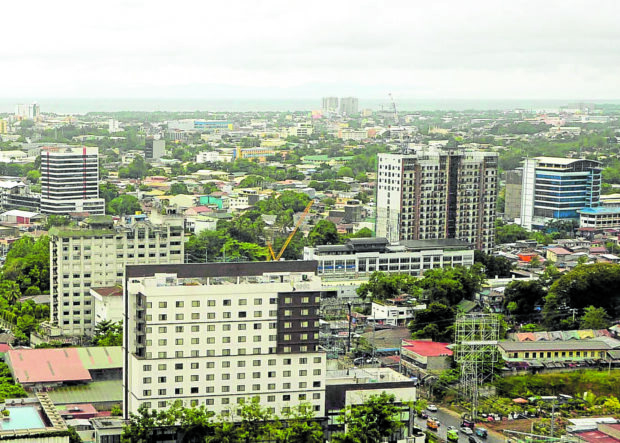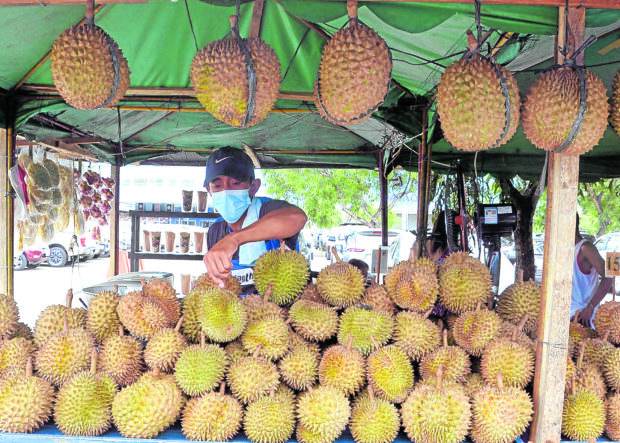Davao secures status as main gateway to Mindanao

RISING Davao’s changing skyline indicates a booming property sector. More high-rises are being constructed to meet a growing demand for office and residential condominiums. —BING GONZALES
DAVAO CITY—It is famous for Mount Apo, the country’s highest peak, a variety of fruits, chocolates, cheese, parks, and beaches and called by so many nicknames: “Jewel of the South,” “King City of the South,” “Crown Jewel of Mindanao,” “Durian Capital of the Philippines” and the latest, “Chocolate Capital of the Philippines.”
By whatever tag, the first-class city of Davao is Mindanao’s prime urban center and the main entry point to the southern region whose economy, valued at least P3.4 trillion in 2022, has immense potential for growth, especially in agriculture.
The city, according to John Carlo Tria, president of the Davao City Chamber of Commerce and Industry Inc., is the gateway to Mindanao, a market of over 26 million people, which is larger than the combined population of Southeast Asian countries Cambodia and Laos.
“When we speak of Davao, we don’t only speak of the city but [of] the entire region; in fact, the entire Mindanao because when investors arrive here, they treat Mindanao as a whole,” Tria told the Inquirer.
Many businesses that have Mindanao-wide operations are located in the city, among which are fruit-exporting companies and those in retail trade, taking advantage of the logistical ease Davao has to offer as well as the potentials for generating sales.
With a population of 1.8 million, its economy was valued at P454.7 billion in 2021, growing at 6 percent from its level a year earlier, or right after the pandemic’s beating.
This shows the resilience of the local economy, noted Tria.
Not only that, it is also helping drive the growth of the Davao Region as the total value of the city’s economy in 2021 accounted for 51.6 percent of the region’s economy, per data from the Philippine Statistics Authority.
A big part of the regional economy’s 8.1 percent growth in 2022 was generated in the city which has seen large strides in tourism industry recovery.
According to Tanya Rabat-Tan, regional director of the Department of Tourism, there was a 65-percent increase from last year’s number of visitors in the region.
“We have 1.8 million this year as of the second quarter. It’s still domestic, local (travelers). There was also an increase in foreign travelers, 2 percent for last year and 3 percent this year,” Tan told the Inquirer, adding that the numbers could climb further if people continue to perceive the city as a safe destination.
Prior to the pandemic, tourism, particularly the Meetings, Incentives, Conferences and Exhibitions (MICE) market, has been the main growth driver of the local economy.
In the 11 months of 2019, tourism receipts in the city amounted to P51 billion, generated from some 2.34 million arrivals. The City Tourism Operations Office said the bulk of the revenues came from the MICE segment. The tourism receipts almost doubled in just four years, from P26.2 billion in 2015.
As this large segment of the economy ground to a halt with the pandemic, even large players were shaken: Marco Polo Hotel and Apo View Hotel had to close. Marco Polo’s reopening is touted as the best indicator of the city having regained its position in the MICE market.

CONSUMER SPENDING A growing population and increasing tourist arrivals combined to boost demand for consumer goods in Davao, such as traditional fruits mangosteen and durian and meat products. —PHOTOS BY BING GONZALES
‘Bleisure’ destination
Part of the local government’s strategy of tourism rebirth is promoting the city as a “bleisure destination” given its varied cultural, entertainment and leisure offerings, on top of high-quality accommodation and other related facilities for the conduct of business meetings. “Bleisure” is a type of travel that combines business and leisure.
“Tourism is a low-hanging fruit that should be optimized” in the city’s economic recovery drive, said Arturo Milan, vice president for Mindanao of the Philippine Chamber of Commerce and Industry (PCCI).
Covering an area of 2,443.61 square kilometers, the city is well-positioned to be an agricultural powerhouse so Milan has advocated for agritourism, both to generate economic value from catering to the service needs of tourists and to harness the strong potentials of farming to its long-term growth.
Although the direct physical manifestation of Davao’s economic production is agricultural given the large tracts of land cultivated for fruits, its economy is largely services-oriented, mainly retail trade and business process outsourcing, and buoyed by remittances from overseas workers, Milan said.
Established as a settlement following the conquest by Spanish forces in 1849, Davao progressed by producing commodities for the global market, mainly abaca, coconut, and lumber.
From a frontier settlement, it has grown into a major port locality with links to Japan, the United States and Australia. Japanese and American businessmen and workers were attracted to Davao due to its agricultural and forestry riches.
But as it transformed as a locality through the years, Davao’s economy has radically shifted away from its roots.

A growing population and increasing tourist arrivals combined to boost demand for consumer goods in Davao, such as traditional fruits mangosteen and durian and meat products.
Lessons from pandemic
The lessons of the pandemic should be instructive enough not to rely on only one leg, Milan said.
“The three legs of the economy, that is, services, agriculture and industry, should stand in balance,” said Milan, who used to head the Davao Light and Power Inc., the city’s local power retailer.
Milan said that the generation of quality jobs in large numbers is through manufacturing, “by developing our industrial base.” With its potential in agriculture, the city can go the way of agri-based industrialization, he added.
“Growth has to be internally generated,” he said.
One predicament for attracting large-scale industrial locators in the city is the absence of vast tracts of land to host manufacturing operations, as in an economic zone.
Milan said the joint venture entered into by outgoing Mayor Rodrigo Duterte in 2015 with a business consortium could have developed this capacity had it not been scrapped. The city’s coastal reclamation project aimed to develop over 200 hectares of land for mixed uses.
But at this time, Milan said this issue can be addressed by investors entering into ventures with private land owners. For this, the local government needs to also provide incentives for local property owners who help host these investors, he added.
But for other commercial pursuits, the city’s property market seemed prepared to cater to new business locators.
Plug and play
The city, Tria said, is primed for new business locators now with the availability of “investment-ready” properties that could easily allow small-scale investors to come in and immediately set up shop.
He was referring to mixed townships and vertical property development and high-rise office condominiums that had been sprouting in the city.
“Before 2016, we were already involved in investment promotion but when we invited investors, what could we show them? A lot of the time we had to show them raw land, not yet ready for investments. We had a lot of experiences when we brought investors to a property and all they could see was coconut grove,” he recalled.
“Now, they don’t have to wait for the building to be constructed, they can easily set up shop,” he said. “Plug and play, that’s very important for investors because if you don’t have that kind of property and you have to make them wait, they’ll likely go elsewhere, they can’t wait too long.”
He said not all investors, especially the small ones, were willing to build everything from zero. “The big conglomerates, yes, they can turn the raw land into development but most investors are not that big. They want something that is ready, that they can probably rent, somewhere they can enter right away,” Tria explained.
Many of the properties being opened here now are already outside the city’s core, so he expected there would be more investments in warehouse type facilities that agro-processors and even other light manufacturing industries could make use of.
Milan noted that the property development sector in the city was not as affected by the pandemic as others. Now with economic activities humming fully, he expects the sector to register more growth.
Helping drive property development here, according to Milan, is the proclivity of overseas workers and wealthy families from other Mindanao provinces, to buy housing units where their children and other family members could live while pursuing college in the city’s universities.
“Families really spend for the education of their children,” Milan stressed. And this spending has also led to the expansion of tertiary schools in the city.
“A concrete validator of the future of Davao is property development. (Although) this partly drives land speculation, this is an indicator that people will continue, and are interested, to flock here in the years to come,” Milan said.